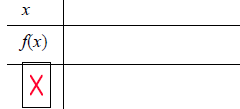Quadratic Functions and Concavity
Why?
We have dealt with functions whose rate of change was constant, namely, linear
functions.
Such functions are either increasing or decreasing or constant, and they do not
bend.
Quadratic functions are both increasing and decreasing and bent up or down. If a
function is
increasing like the stock market does sometimes, it is useful to know if the
functions are
increasing at an increasing rate (like some exponential growth functions) or at
a decreasing
rate.
Overview
We have studied linear functions. We will now study functions that are
non-linear like
quadratic functions. An important aspect of such functions is how their
graphical
representations are bent. Are they bent up or down, are they concave up or
concave down?
In calculus, you will study ways of determining the concavity of a function from
its formula.
Here, we will determine the concavity from tables and graphs.
Prerequisites
1. An ever-growing knowledge of function notation.
2. You previous knowledge of quadratic equations and their graphs.
3. The ability to determine if a function is increasing or decreasing from its
average rate
of change.
4. An ability to analyze the behavior of a function from its graph.
Learning Objectives
1. You will learn to find the zeros of quadratic functions.
2. You will learn what concave up and concave down mean and how to determine the
concavity of a function from its tabular or graphical representation.
3. You will learn what concavity means for increasing and decreasing functions.
Performance Criteria
1. You will be able to graph a quadratic equation quickly and accurately by
hand.
2. You will be able to determine the concavity of a quadratic function.
3. You will be able to use tables and graphs to determine the concavity of other
types of
functions..
Vocabulary
1. Real zeros (complex zeros) of a quadratic function
2. Concave up, Concave down
3. Bent up, Bent down
4. 
5. Solution of a quadratic formula
6. Quadratic Formula (you will need to memorize this formula if you have not
already).
Resources
1. Section 2.5 and 2.6 and previous sections of our textbook.
2. Your previous experience with quadratic equations and the Quadratic Formula.
3. Your graphing calculator.
Plan
1. Read the Critical Thinking Questions
2. Read Sections 2.5 and 2.6.
3. Answer the Critical Thinking Questions.
4. Applications
5. Problem Solving
Model
1. Examples 1 and 2 in Section 2.5 and Examples 1-5 in Section 2.6 of the text.
2. Examples given by the instructor.
Critical Thinking Questions
1. What is the Quadratic Formula and what does it have to do with finding the
zeros of a
quadratic function?
2.Is a linear function concave up or concave down? How does the rate of change
of a
linear function change? Does it increase or decrease or stay constant? Give an
example in the table below where f is a linear function that you make-up.

3. How would an increasing, concave up function look?

4. What are the real zeros of the quadratic function
 ? You may wish
? You may wish
to use factoring in finding the zeros.
5. What are the real zeros of the quadratic function

6. What is the concavity of the function  ?
You may wish to graph
?
You may wish to graph
the function with your graphing calculator.
7. Can you draw a function graph that is both concave up and concave down? Do
so, if
you can.

Applications
In Section 2.5: exercises #1, 2, 3, 5, 6, and 9
In Section 2.6: exercises #1, 2, 3, 5, 9, and 11
Problem Solving
In Section 2.5: problems #11, 13 14, 17, 18, and 19*.
In Section 2.6: problems #13, 15, 17, 18, and 21
Self-Assessment
Can you find the zeros of a quadratic function?
Can you determine the concavity of a function from its graphical representation?
From a
table of rates of change?
Do you feel comfortable with the notions of bending and concavity?
Extensions
Can you find an cubic function that has 3 real zeros and concave up to the left
of zero and
concave down to the right of zero?
If a function is increasing and concave up, can it be asymptotic to the line y =
5?


